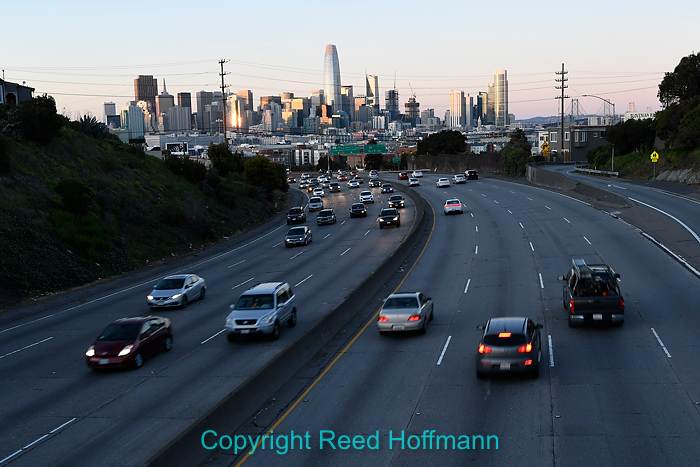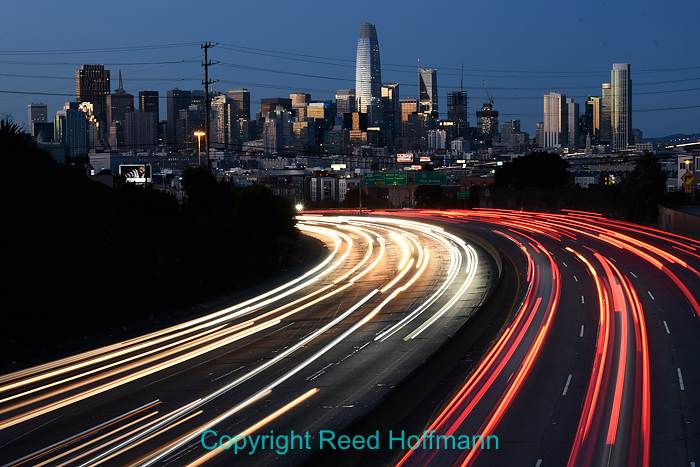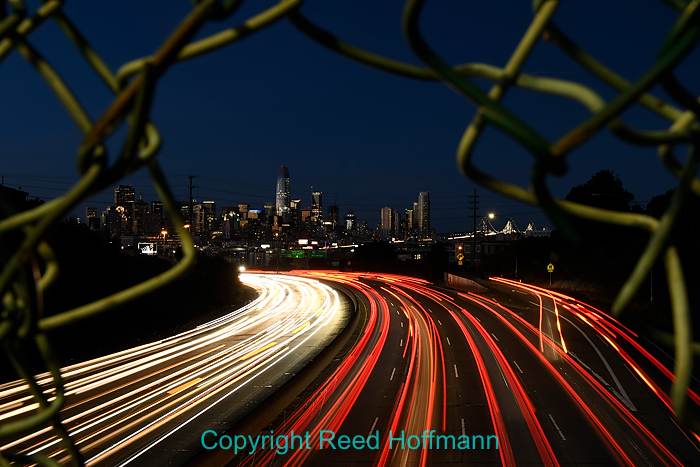I’ve got a list of photos I’m always looking to make. Among those is a better long exposure night photo of traffic, with a great skyline in the background. I recently had another opportunity to try that, with a local who knew where to go. It was a good spot. I shouldn’t have been surprised, though, since this local is a former National Geographic photographer.
If you were a reader of the magazine in the 70s and 80s and cared about photography, you’d recognize the name Jim Sugar. He traveled the world doing dozens of stories for the magazine and was one of their best. Jim now lives in the San Francisco Bay area, and I had the pleasure of meeting him about ten years ago on a winter trip to Yosemite. We’ve stayed in touch since, so I asked if he wanted to get together for some photography on my recent trip there to teach Nikon School. He was game, and had some ideas. One of those was that shot I keep looking for.
To get that picture, everything has to come together in just the right way. First, you need an elevated position. Next, lots of traffic on a curving highway below. And finally, a good skyline at dusk in the distance. Jim knew of a pedestrian walkway that would give us that, and even that someone had cut a hole in the fence – at just the right height – for pictures. If we were lucky, the hole would still be there.
After teaching my last class late Sunday afternoon, we headed out. Our timing was perfect. The previous days’ rains were gone and we arrived just before sunset. That was important. For a lot of night photography, it’s best to start with some light in the sky. That will usually give you a bit of blue in the sky instead of just black. And being on location before sunset meant we had time to get our gear together and do some tests.

This is how the scene looked when we arrived. Another photographer who was already there shot a few pictures before the light got good and left. Which was a mistake. The better pictures would come as it got darker. And note how distracting the telephone poles and wires are. Nikon DSLR, Aperture Priority, ISO 200, 1/60 at f/5.6, -1.0 EV, Nikkor 16-80mm lens at 40mm. Photo copyright Reed Hoffmann.
The first photos, however, weren’t what I’d hoped for. While the curve of the highway and the skyline were good, there were telephone poles and wires crossing the frame. I had two possible solutions for this, neither of which involved chainsaws or being arrested. If I shot the photo with wider framing, everything would appear smaller and the lines less noticeable. Zooming out, I could also use that hole in the chain link fence as a framing device. And, as it got darker, those lines would be less visible.

This is the light I wanted (some blue still in the sky), but this framing still shows off the wires too much. Nikon DSLR, Manual exposure, ISO 100, 3-seconds at f/18, Nikkor 16-80mm lens at 63mm. Photo copyright Reed Hoffmann.

By backing out the framing I was able to minimize the visibility of the lines, and use the torn fencing as a framing device. Nikon DSLR, Manual exposure, ISO 100, 3-seconds at f/16, Nikkor 16-80mm lens at 37mm. Photo copyright Reed Hoffmann.
So that’s what we did over the next hour. Changing framing, changing exposure, shooting as the sky darkened into night. Vibration was also a factor. Being a pedestrian bridge, no vehicles were crossing it. But if a person passed by – and many did – that created enough movement to incur blur. Even a large truck passing underneath us created enough of a breeze to blur my three-second exposures. So I shot LOTS of frames.
While I was doing that, Jim played with a 16mm full-frame Nikkor fisheye lens. Not for photographing the traffic and skyline (they’d be too small with that lens), but making pictures of me at work. He also added a flash (Nikon SB-700) on the railing on the opposite side, to create some dramatic backlight. He’d also brought along an amber (warming) gel for the flash, to create a warmer skin color. And then I made some photos of Jim with that setup. Despite being at slow shutter speeds (around ½ -second), we shot that picture hand-held. The flash would freeze any movement of the subject, and adding a little camera movement blur to the rest of the scene would actually look interesting.

Jim Sugar on the overpass, working the scene through the hole in the fence. The warm light on his face is from an orange gel (filter) on the flash below and to the far side of him. Nikon DSLR, Manual exposure, ISO 400, 1/2 second at f/5.6, Nikkor 16 mm f/2.8 lens. Photo copyright Reed Hoffmann.
As much as I enjoy teaching, what I truly love is making pictures, and that’s more fun with friends. While I was pretty happy with the pictures we made, more importantly, I had a great time with Jim. For me, photography is as much a great shared social experience as it is about making pictures.
(If you like this, please share it with your friends, and let them know about the links about photography I post on my business Facebook page. I’m also on Instagram and Twitter, @reedhoffmann)

